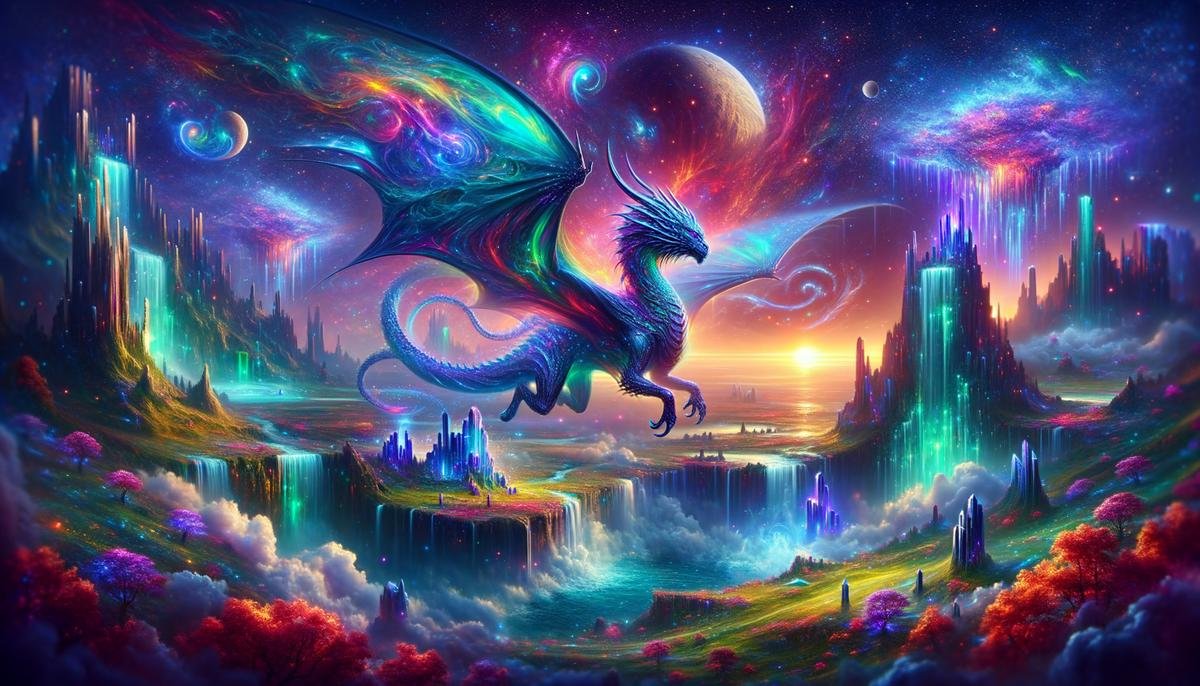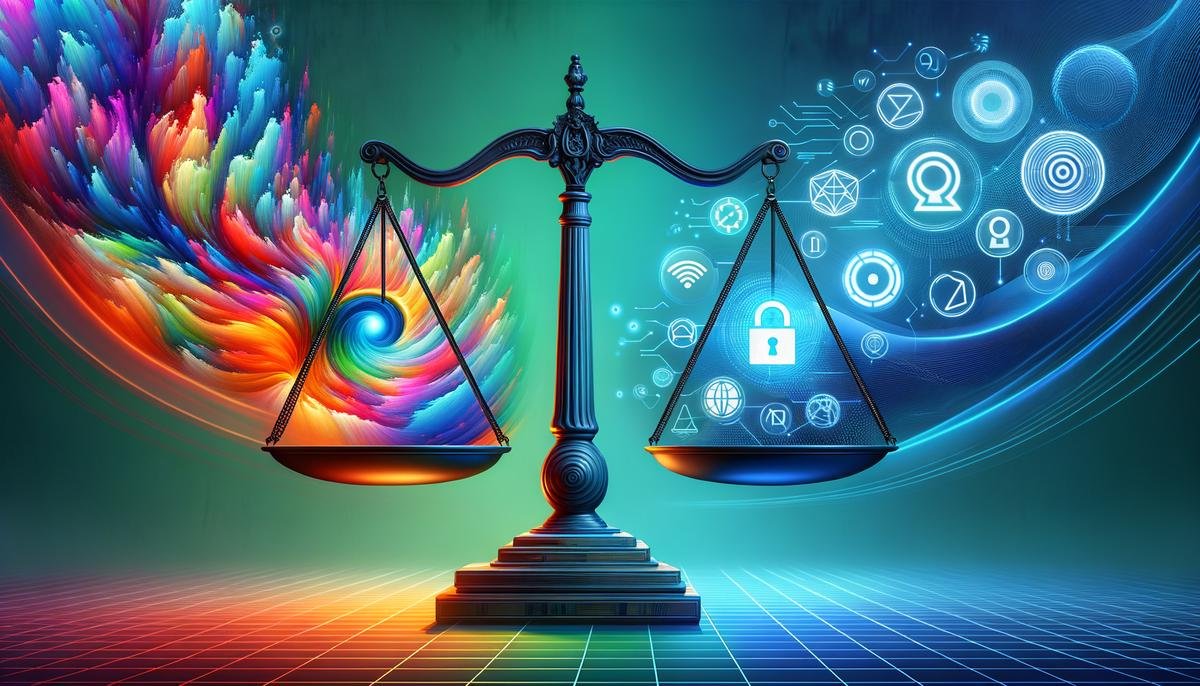Understanding DALL-E 2
OpenAI's DALL-E 2 stands as a milestone in generative AI technology, harnessing diffusion models to reinterpret text prompts into visual artwork. Unlike simple filter applications or photo editing tools that tweak existing images, DALL-E 2 embarks on creating visuals from a mere string of text. This capability underscores a significant leap from its predecessor, driven by a more finely tuned understanding of image attributes and spatial coherence.
DALL-E 2 operates on a trained neural network modeled similarly to GPT-3, OpenAI's language processing AI. This structure allows the system to assess text—transforming words into detailed images. The diffusion model incrementally constructs pictures, starting from random noise and progressively refining details up to a high-resolution output.
Each prompt fed into DALL-E 2 activates a cascade of internal processes: it taps into a previously learned dataset imbued with millions of images tagged with descriptive texts. Through this, the AI recognizes patterns and features enabling it to conjure up graphics that align with the verbal descriptions provided by users. For instance, when requested to materialize a "sunset over a serene lake," DALL-E 2 pulls from its learned correlations of sunsets and lakes to produce an art piece characterized by these elements.
Users must harness the power of precision in text prompts. Being specific about the style, scene composition, and key elements helps channel the AI's capabilities more effectively. Missteps in phrase construction can lead to fluidity in generated interpretations, often resulting in mixed illustrational outcomes—a reminder of the nuanced interaction between human oversight and AI execution.
The realm of AI-generated art via DALL-E 2 opens diverse applications, from artistic endeavors to practical uses like marketing content and visualization aids. Real-time adjustments in prompt phrasing aid in closer realizations of the user's envisioned graphic, unfolding a symbiotic relationship between AI technology and human creativity.

Using DALL-E 2 Effectively
Crafting effective prompts is pivotal for optimizing your experience with DALL-E 2. Precision in language instructs the AI with clarity, steering the generated artwork closer to your intention. To harness this, conceptualize your prompt carefully. Start with the main subject and progressively incorporate specific details, such as actions, environment, and mood, which can lend depth and context to the scene. Refining your descriptions such as "a small wooden cottage on a snowy hill at sunset" rather than just "a house in winter," encourages a more vivid and accurate manifestation.
In-app tools, like inpainting and outpainting, further refine or expand your images post-creation.1
- Inpainting allows you to edit specific areas of the generated image—perfect for correcting parts that didn't turn out as expected.
- Outpainting lets you extend the borders of your image, adding more context or transforming a simple portrait into a larger landscape scene.
Both tools are crucial for iteratively improving the artwork and adapting final visuals to specific needs or creative desires.
Identifying and acknowledging the software's limitations can also lead to better outcomes. DALL-E 2 occasionally struggles with complex scene compositions or rendering hyper-realistic textures and may misinterpret spatial relations or subjective colors.2 Identifying these quirks can guide you in creating prompts that avoid known pitfalls, or it might inspire you to creatively incorporate these anomalies into your artistic vision, embracing the distinctive style of AI-generated art.
Thorough trials with varying detail levels in prompts can provide insights into the breadth of DALL-E 2's capabilities and limitations. Crafting and iteratively refining prompts based on observed output helps build a nuanced understanding of how DALL-E 2 interprets text, enabling more informed and effective use of this cutting-edge tool in your creative or professional projects.
Ethical and Policy Considerations
The explosion of AI-generated art, epitomized by platforms like DALL-E 2, raises profound ethical questions and concerns, particularly regarding copyright and the potential misuse of this powerful technology. While DALL-E 2 democratizes artistic creation, offering users the ability to generate images from simple text descriptions, it also navigates intricate copyright territories traditionally governed by human creativity and intellectual property rights.
As a technological frontier, DALL-E 2 adheres to a rigorous content policy that explicitly avoids generating images that can be deceptive or harmful. This includes restrictions against creating photorealistic images of public figures or anything that could contribute to deepfake technology, which has significant implications for misinformation and privacy violations.3 The software is also programmed to reject requests that could produce violent, hateful, or adult content, ensuring that the outputs promote a safe and positive use of AI innovations.
In addition to programmed restrictions, OpenAI has implemented measures to mitigate copyright issues. As DALL-E 2 generates images based on a composite learning from a broad dataset of copyrighted images, questions about the originality and ownership of AI-generated content become prominent. OpenAI addresses this by granting users ownership of the new images they create, entitling them to commercialize or redistribute these images.4 However, it's important to consider the underlying contributions of the countless unrecognized and uncompensated original artists whose works are digested by the AI in its training phase.
To prevent misuse and manage ethical considerations proactively, OpenAI has established a monitored deployment strategy. Stricter controls and human oversight are crucial in phases where user interaction provides further data crucial to refining the AI's ethical governance frameworks.
As these technologies become more integrated into societal frameworks, continuous updating of policies based on both technological advancements and societal feedback will be essential to harness AI's capabilities ethically and effectively.

Creative Applications of DALL-E 2
Among the most fascinating imaginations brought to practicality with DALL-E 2 are businesses who've redefined marketing and content creativity through AI integration. Each example underscores the shift from conventional artistry to expedited, mold-breaking innovations.
For instance, a fashion retailer experimented with DALL-E 2 for its seasonal advertising campaign, yielding peculiar yet captivating results. Upon detailing inputs like "a summer dress on a mannequin surrounded by sand and sea creatures," the resultant images retained striking undersea elements alongside sharply featured apparels. This use of DALL-E not only cut back significantly on logistic costs associated with photoshoots at exotic locations, it also implanted a brand identity drenched in creativity and forward-thinking.
Content creators on social media have tapped into DALL-E 2 effectively as well. A notable YouTuber known for DIY projects created a series detailing "how-to" guides for crafts. However, instead of traditional introductory thumbnails, they implemented visually enthralling prompts to illustrate unrealistic projects—like "a birdhouse woven from rays of sunshine"—which spiked curiosity and clicks, leveraging the surreal aura of AI-generated artwork to magnify audience draw.
In marketing arenas, one standout usage was for conceptualizing future product developments. A tech company innovating in smart wearables used DALL-E 2 to preview potential product designs and their benefits in everyday scenarios. Through generating images portraying futuristic concepts like "a jacket adapting its color and texture based on the weather", they effectively stimulated interest and feedback far before actual prototyping, setting a thought-provoking stage for innovation discourse.
The influence of DALL-E 2 on creativity and production processes is profound. It radically alters timelines for development and deployment of marketing collaterals, empowers brand differentiation via unique visual artworks, and catalyzes a transition to dynamic storytelling whereby audiences access an immersive graphical world, revolutionizing engagement metrics.

Future of AI in Art Generation
The evolution from DALL-E 2 to DALL-E 3 represents a crucial threshold crossed in the field of AI-driven art creation. Bridging the gap between what's feasible and what's imaginable, DALL-E 3 amplifies the intricacies of AI image generation, offering higher resolution outputs and more coherent images that better understand and interpret the depth and context implicit in user prompts.5 As we continue to witness these technological strides, the implications extend far beyond the realm of creative arts into sectors like advertising, education, and even therapeutic practices.
DALL-E 3's refined algorithms and expanded dataset encompass a broader array of artistic styles and cultural nuances, enabling the AI to produce images that resonate more deeply with global audiences. This inclusivity opens up new avenues for localized and personally relevant marketing strategies. For instance, a brand could generate custom visuals that align with the cultural aesthetics and values specific to various geographical locations, creating more impactful and meaningful engagement with diverse consumer bases.
As the interface and user interaction with AI art generation tools become more intuitive, barriers to entry lower, allowing non-artists to explore their creativity. This democratization of art through technology could foster a new wave of user-generated content, wherein enthusiasts not formally trained in artistic skills can bring their unique visions to life, potentially spurring a cultural shift in art creation and consumption.
As we speculate on future developments, the integration of AI with augmented and virtual reality technology stands out as a particularly promising horizon. Such synergy could lead to entirely new forms of interactive art where viewers can step into and experience the artwork itself, influencing its evolution in real-time through their actions and reactions within the art space.
Despite the explosive potential for innovation, it remains crucial to move forward mindfully. The increased capability of AI like DALL-E 3 to generate photorealistic images raises heightened concerns about ethical issues, such as deepfakes and the need for robust mechanisms to prevent the creation of deceptive or harmful content.6 Additionally, as these technologies develop, so too must copyright frameworks evolve to address new complexities in AI-generated content and its implications for original human creators.
Balancing these concerns with the incredible promise of AI in art generation will require ongoing collaboration between developers, artists, legislators, and the public. Together, these stakeholders can shape a future where AI augments human creativity in a way that enriches society culturally, ethically, and artistically. With careful steering, the future of AI in image generation could redefine artistry and our broader visual and interactive landscape.

- Ramesh A, Pavlov M, Goh G, et al. Zero-Shot Text-to-Image Generation. arXiv. Published online February 24, 2021.
- Boersma M. The Promise and Limitations of AI Image Generation with DALL-E 2. Towards Data Science. Published online August 11, 2022.
- Vincent J. OpenAI's new AI model can create images from text, but it's not ready for public release. The Verge. Published online April 6, 2022.
- Orme B. Who Really Owns AI-Generated Art? Artsy. Published online July 22, 2022.
- Heaven WD. OpenAI's new language generator GPT-3 is shockingly good—and completely mindless. MIT Technology Review. Published online July 20, 2020.
- Kietzmann J, Lee LW, McCarthy IP, Kietzmann TC. Deepfakes: Trick or treat? Business Horizons. 2020;63(2):135-146.



